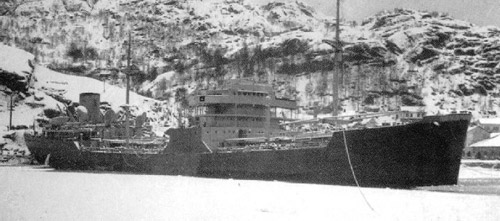The Mystery of Murmansk
The War Illustrated, Volume 2, No. 28, Page 229, March 15, 1940.
Something is happening at Murmansk, but what is difficult to perceive through the fog of rumour. Below we give a review of possible moves in that quarter, accompanied by an account of the Murmansk Expedition, still fresh in the memories of many ex-Servicemen.
Murmansk is in the news again – Murmansk, Russia's port on the Arctic, her only ice-free port in northern waters, if one leaves out of the question those recently "leased" in Estonia and Latvia. A few months ago it provided a refuge for the homecoming "Bremen" and for the "City of Flint", the "Deutschland's" captive. Now there are reports of German submarines sheltering in its harbour, watched by British naval units just out at sea; rumours, too, of unrest and confusion in the town itself where the people, half-starved owing to the frequent breakdowns on the railway linking Murmansk with Leningrad, are said to be in daily fear of bombardment by the Allied warships.
Less than 25 years ago Murmansk was just a collection of log huts, but in 1916 the completion with British aid of the railway line across the Kola peninsula, and so on through Kandalaksha and Kem on the White Sea to what was then Petrograd, led to a rapid development, for along this railway were dispatched huge quantities of military stores sent from Britain and America to their ally, the Russia of the Tsar.
Under Soviet rule the district has been extensively colonized, and many improvements have been made in the port. Shipbuilding yards have been constructed, and not only is Murmansk the centre of a flourishing fishing industry, but it is the port from which huge quantities of timber, cut by political convicts in the forests of the Kola peninsula, are exported. Much of this timber has gone in the past, and still goes, to Germany, and perhaps the presence of the British fleet is intended to put a stop to this traffic in a vital war material. Another reason may be the considerable number of German merchant-ships which took refuge in the harbour at the outbreak of war and are still there, waiting a favourable opportunity for dashing out and making for home. While most of their homeward journey could be made in Norway's territorial waters, before these can be reached from Murmansk there has to be traversed a gap of some forty miles of Finnish water in front of Petsamo; and it seems reasonable to suppose that somewhere in the vicinity the Allies have set their trap for homebound skulkers.
When the British Held Murmansk
Just over twenty years ago, it is interesting to recall, Murmansk was occupied by a British Expeditionary Force under General Maynard (now Maj. Gen. Sir Charles Maynard). This was dispatched in the spring of 1918 to protect and occupy part of the recently-constructed Murmansk railway, which was then being threatened by an army of Finns under German control; other reasons were the desire to save from the Bolshevik hordes then overrunning the distracted country the large quantities of military stores at Murmansk, and to create a diversion which would dissuade the Germans from releasing more of their divisions on the Eastern front for service in the West. The first units landed in February 1918, but Murmansk itself was not occupied until June, when an army composed of British, French, and American contingents was landed. At first the local Soviet supported the invaders, and the Allies were able to push down the Murmansk railway, occupying Kandalaksha and Kem on the White Sea (places recently threatened by the Finn ski-patrols), until in the summer of 1919 they reached the shores of Lake Onega. There was a fight on the lake in which a British flotilla, aided by land and air forces, captured two Bolshevik steamers and took the port of Talvuiski.
A few weeks later the Allies were threatening Petrozovodsk, the Bolshevik base on Lake Onega, some 500 miles south of Murmansk, but in September the evacuation of North Russia was in progress. The Allies withdrew northwards along the railway, closely followed by the Bolsheviks, and by the end of 1919 the Murmansk expedition had passed into history.
The commander of the expedition to Archangel, which was part of the same scheme of operations, was Gen. Ironside, now Chief of the Imperial General Staff.
Index
Previous article
This Neutrality is a Queer Business
The "Altmark" incident (fully described in pages 171-173) set a pretty problem in international law. So direct was the conflict of opinion between Britain and Norway that the latter suggested that the
Next article
Things You May Not Know
"Amps". Auxiliary Military Pioneer Corps; R.E. construction companies attached to the B.E.F. The members are voluntary recruits, many of them over the age of forty. Their work includes road-building,




